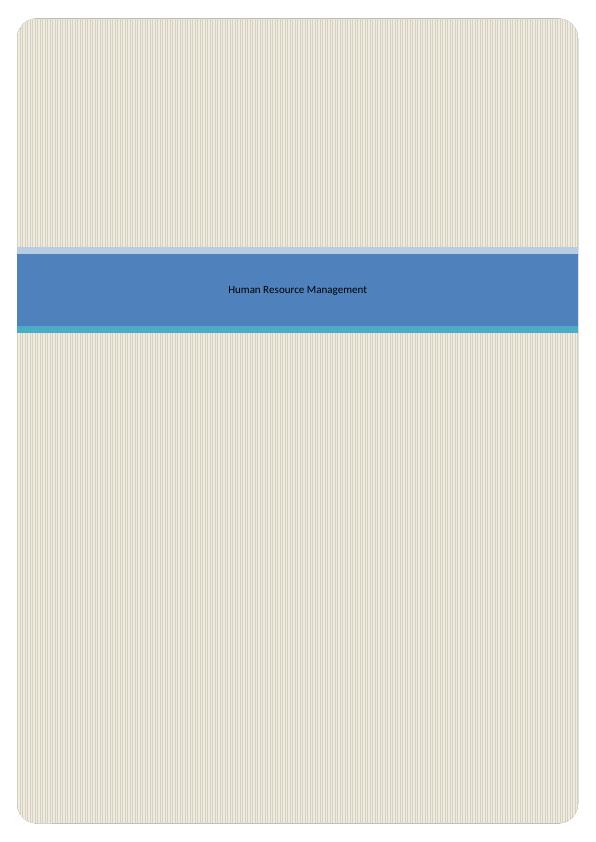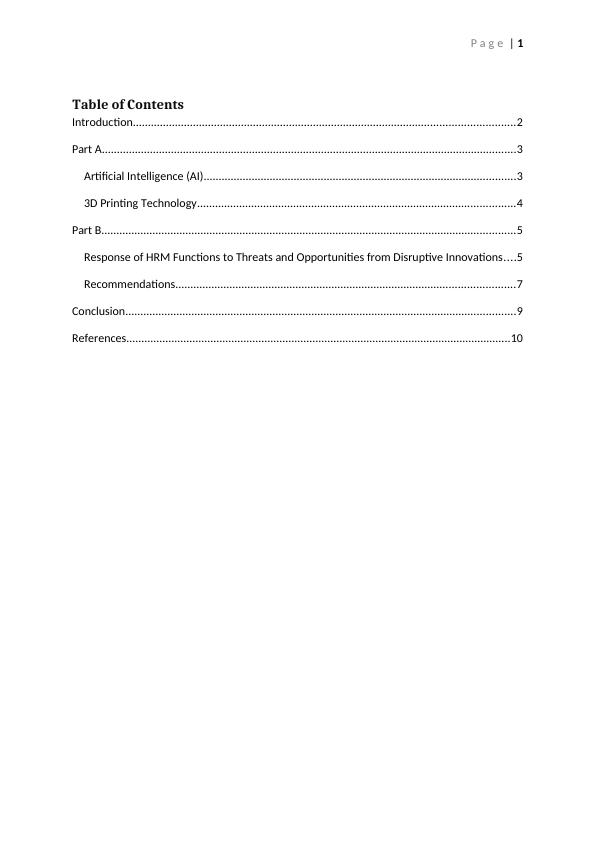Response of HRM Functions to Threats and Opportunities from Disruptive Innovations
Added on 2023-04-17
13 Pages2628 Words407 Views
Human Resource Management

P a g e | 1
Table of Contents
Introduction...............................................................................................................................2
Part A..........................................................................................................................................3
Artificial Intelligence (AI)........................................................................................................3
3D Printing Technology..........................................................................................................4
Part B..........................................................................................................................................5
Response of HRM Functions to Threats and Opportunities from Disruptive Innovations....5
Recommendations.................................................................................................................7
Conclusion..................................................................................................................................9
References................................................................................................................................10
Table of Contents
Introduction...............................................................................................................................2
Part A..........................................................................................................................................3
Artificial Intelligence (AI)........................................................................................................3
3D Printing Technology..........................................................................................................4
Part B..........................................................................................................................................5
Response of HRM Functions to Threats and Opportunities from Disruptive Innovations....5
Recommendations.................................................................................................................7
Conclusion..................................................................................................................................9
References................................................................................................................................10

P a g e | 2
Introduction
In today’s competitive business world, organisations rely on disruptive innovations in
order to generate a competitive advantage in the business because it enables them to
change as per the market conditions. Many incumbents have failed in the market because
challengers rely on disruptive innovations to exploit their customer base and gain a
competitive advantage in the market (Gobble, 2012). These disruptive innovations also
create threats or opportunities for human resource management (HRM) practices which
companies have to take into consideration while implementing HR strategies (King &
Baatartogtokh, 2015). The objective of this report is to evaluate two disruptive innovations
and their potential implications for HR managers. This report will evaluate Artificial
Intelligence and 3D Printing technology as the two disruptive innovations that have
impacted businesses across the globe in the last decade. This report will analyse the
example of Unilever and Boeing along with other corporations to understand how these
disruptive innovations create opportunities and challenges for companies. The second part
of this report will evaluate the HRM functions in responding to the potential threat or
opportunities from the disruptive innovation and their impact on the organisation.
Recommendations will be given for organisations that will assist them in playing a proactive
role to prepare for these disruptive innovations.
Introduction
In today’s competitive business world, organisations rely on disruptive innovations in
order to generate a competitive advantage in the business because it enables them to
change as per the market conditions. Many incumbents have failed in the market because
challengers rely on disruptive innovations to exploit their customer base and gain a
competitive advantage in the market (Gobble, 2012). These disruptive innovations also
create threats or opportunities for human resource management (HRM) practices which
companies have to take into consideration while implementing HR strategies (King &
Baatartogtokh, 2015). The objective of this report is to evaluate two disruptive innovations
and their potential implications for HR managers. This report will evaluate Artificial
Intelligence and 3D Printing technology as the two disruptive innovations that have
impacted businesses across the globe in the last decade. This report will analyse the
example of Unilever and Boeing along with other corporations to understand how these
disruptive innovations create opportunities and challenges for companies. The second part
of this report will evaluate the HRM functions in responding to the potential threat or
opportunities from the disruptive innovation and their impact on the organisation.
Recommendations will be given for organisations that will assist them in playing a proactive
role to prepare for these disruptive innovations.

P a g e | 3
Part A
Artificial Intelligence (AI)
AI is also referred as machine learning in the field of computer science which is
referred to the intelligence demonstrated by machines in contrast to the natural intelligence
which is displayed by human beings and other animals (Russell & Norvig, 2016). AI is
considered as one of the most disruptive innovations of all because of its ability to change
the world. The way people work can be fundamentally shifted through AI because
computers can be used to perform those tasks which usually require human intelligence to
be performed. AI can identify inefficiencies which humans are not capable of which leads to
improvement of the ways in which businesses manage their operations. Similarly,
individuals can also benefit from advanced AI capabilities through personal assistants and
the automation of everyday tasks such as ordering groceries or organising the calendar
(Makridakis, 2017). The possibilities of application of AI technology are endless which can be
used in order to address a major global issue such as climate change since researchers can
predict its effects and find solutions to mitigate its effects. In the healthcare sector, this
technology can improve health practices by sifting through endless data in order to
recognise potential causative factors of a particular disease. AI technology has affected
different aspects of a business such as marketing, hiring, selection, manufacturing, and
others. Online social media sites such as Facebook rely on AI in order to show
recommendations and advertisements to its users based on their interest to ensure that
they are more likely to click on these adverts (Bell, 2018).
Similarly, Google and Apple also use AI to offer personal assistance to their
customers such as Google Now and Siri that help users in following their instructions
through voice such as setting up calendar, making a web search, calling or texting someone
or others (Wallace, 2016). Organisations such as Unilever use AI technology in order to
conduct their HR functions in effective manner. The company uses this technology to recruit
and train thousands of employees from all across the globe. The company has partnered
with Pymetrics which is a firm that is specialised in AI recruitment technology in order to
create its own online platform from which it screens candidates directly from their homes
Part A
Artificial Intelligence (AI)
AI is also referred as machine learning in the field of computer science which is
referred to the intelligence demonstrated by machines in contrast to the natural intelligence
which is displayed by human beings and other animals (Russell & Norvig, 2016). AI is
considered as one of the most disruptive innovations of all because of its ability to change
the world. The way people work can be fundamentally shifted through AI because
computers can be used to perform those tasks which usually require human intelligence to
be performed. AI can identify inefficiencies which humans are not capable of which leads to
improvement of the ways in which businesses manage their operations. Similarly,
individuals can also benefit from advanced AI capabilities through personal assistants and
the automation of everyday tasks such as ordering groceries or organising the calendar
(Makridakis, 2017). The possibilities of application of AI technology are endless which can be
used in order to address a major global issue such as climate change since researchers can
predict its effects and find solutions to mitigate its effects. In the healthcare sector, this
technology can improve health practices by sifting through endless data in order to
recognise potential causative factors of a particular disease. AI technology has affected
different aspects of a business such as marketing, hiring, selection, manufacturing, and
others. Online social media sites such as Facebook rely on AI in order to show
recommendations and advertisements to its users based on their interest to ensure that
they are more likely to click on these adverts (Bell, 2018).
Similarly, Google and Apple also use AI to offer personal assistance to their
customers such as Google Now and Siri that help users in following their instructions
through voice such as setting up calendar, making a web search, calling or texting someone
or others (Wallace, 2016). Organisations such as Unilever use AI technology in order to
conduct their HR functions in effective manner. The company uses this technology to recruit
and train thousands of employees from all across the globe. The company has partnered
with Pymetrics which is a firm that is specialised in AI recruitment technology in order to
create its own online platform from which it screens candidates directly from their homes

End of preview
Want to access all the pages? Upload your documents or become a member.
Related Documents
Managing Digital Practice Report 2022lg...
|11
|2223
|31
Academic Essay on Artificial Intelligence a Threat or an Aidlg...
|9
|2629
|254
Artificial Intelligence (AI) : Assignmentlg...
|10
|2818
|152
Artificial Intelligence in Fashion Marketlg...
|19
|3903
|359
Impact of Artificial Intelligence on the Business Worldlg...
|7
|1194
|438
Artificial Intelligence and Business Operationslg...
|9
|2105
|408
